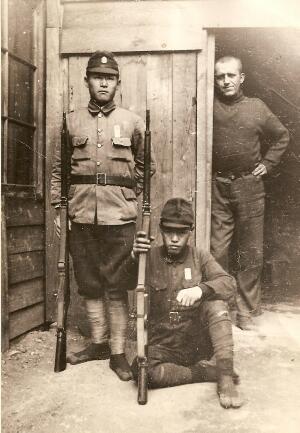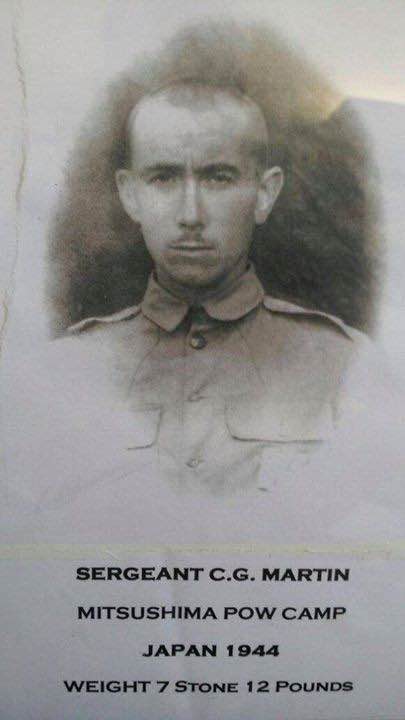| Tokyo
12-B Mitsushima (Hiraoka) Tokyo Area POW Command, Detachment #2 Also called Tenryu or Mitsushima Tok-02D |
Main Main Camp List About Us
|
Location: Tokyo #3-B HIRAOKA aka MITSUSHIMA NAGANO-ken, SHIMOINA-gun, HIRAOKA-mura (or MATSUSHIMA) Nihon Hassoden Co. is now the Chubu Electric Power Co. Actually located in Tenryu village Satellite map Area map Aerial (courtesy of Japan Map Archives) Time Line: 18 Nov 1942: Established; first known as Tokyo 3-B 26 Nov 1942: 85 (81?) Americans arrive from Nagato Maru ex Manila 27 Nov 1942: 120 (183) British arrive late at night ex Singapore on Tofuku Maru. [Surrey Regt, Singapore's Special Training Corps-STC, and RAF] 1 Dec 1942: First man (P/O Bruce, John, 1134189) dies in camp. 28 Jul 1943: (2) Ranking American officers sent to Zentsuji; Lt Col Allan M. Cory and Major Ace E. Faulkner. 1 Aug 1943: Renamed Tokyo-2-D HIRAOKA 16 Apr 1944: 100 men sent to Tokyo 16B-Kanose Carbide Mill; 52 Brits & 49 Americans. 12 Jun 1944: PFC "Harry" Kingen (Medic) arrives from Shinagawa Hosptital. He was the 50th Yank in camp. 20 Jun 1944: Frank Brancaticano dies of starvation- owed food to fellow POWs for cigarettes [Died at Tokyo #16B after transfer]. Aug 1944: Renamed 12-B (KUMAGAI GUMI HIRAOKA HATSUDEN-SHO) 15 Oct 1944- Dr Al Weinstein, Bataan Field Hospital #1 arrives from Omori (Shinagawa Hospital). Dec (?) 1944 - Camp Commandant Capt Nakajima replaced by Lt Kubo. 2 March 1945 - Pilot of B-24 [Capt Van Warmer] brought into camp along with Lt Estabrook (USN) and one British officer 27 Jun 1945 - Capt Oliver Gordon & Lt Cmdr Twiss (HMS Exeter ex-Zentsuji POW Camp) arrive with several other Americans. Gordon and Twiss provide exceptional leadership. 4 Sep 1945: Rescue Effected Present day name: Hiraoka Shi Located on east bank of Tenryu River, Actual location: 35'16"N-137"51'E 13 Buildings (included 3 barracks) surrounded by 10 ft fence. 2 gates. TOTALS: Korean laborers: 3,500 (58 deaths) Chinese POWs: 880 (62 deaths) Allied POWs: 440 The Chinese and Korean slave camps were just upstream. NOTE: Mitsushima is recognized as one of the most brutal camp in all of Japan. Nine (9) guards were convicted and executed from this camp. ["Horyo" p 201-2] Camp had numerous American officers who refused to lead. As a result, officers extremely disliked by the enlisted ranks. Large stores of leather boots from the South African Red Cross were in camp but NEVER issued to the prisoners as the shoes were better than those of the Japanese. ["Horyo" p 160.] Photographs & Sketches:  Leo Grabowski with guards, 1945 "I happened across your website
information about the camp my dad was in for 3-1/2 years, and thought
you might like to see the photo I have of him with guards in front of
him. The story is that a French photographer was taking photos of the
prison guards, and my dad stepped out of the doorway behind them. He
told me that had they known it, he would have been beaten. The
photographer found my dad after the surrender and sent him the photo."
--Ed Grabowski
 Image courtesy of Geoff Martin Japanese Camp Staff: Guard nicknamed "Little Glass Eye," Tatsuo Tsuchiya was convicted for the beating death of Pvt. Robert Gordon Teas. However, we do not find his name on the Gibbs list of deceased. See this page for deposition and news articles. |
Primary
Labor Use: Stevedores carrying cement for building of a dam. Japanese Contractor: Honcho was Igarashi (Source: "Horyo", p157). Other contractor Oiwa (blacksmith shop), Kamijo (machine shops) and Iwatia (general laborers), "Horyo" p166. The GIBBS Report- Detailed description including a partial LIST of the deceased Hell Ships: Nagato Maru ex Manila. 17 day voyage, 1,600 pows, 20 deaths per Michno book, "Death on the Hellships." Gordon ["Horyo"] states men boarded on Nov 7th, stopped at Takao, Formosa for two days, and arrived in Moji on 25 Nov 1942. Train north-east had three groups of men, only one sent to Mitsushima [two groups to Tanagawa and Umeda]. From train, men walked over a mountain in summer gear through snowstorm at night with three men dying along the way. (Names not known) Reboarded another train to camp. British arrived on Tofuku (Fujuku) Maru: ex Singapore on 27-28 October 1942. Arrived Moji 27 November 1942; 27 died en route entrained from Moji and arrived night of 27 Nov 1942. Camp Rosters at Liberation: British (215) and American (93) Survivors plus deceased Americans; No Dutch at rescue Source: NARA: Rg 24, Box 6- Unidentified Camp; RG 407 Box 188- Hand written roster confirmed by Roger Mansell to be a pre-liberation roster of Mitsushima. Handwritten and undated - but very accurate. Additional notation of deceased added by Roger Mansell, Center for Research. List of men who had earlier been transferred out to Kanose at noted in timeline, 16 April 1944. Seeking Contact: Do you remember Denning? Includes PICTURE of all men before rescue. List of deceased at Mitsushima External Link 48 men perished - Gordon, 'Horio" p148 Interviews [External Link] Major Gordon's post war meeting with former Japanese guards; history of War Crime Trials against guards. Books about Mitsushima: "You Shook My Hand"- extracts from the diaries of Sgt William C. Rose, RAFVR. Excellent camp maps for Matsushima and pictures of Kanose camp: ISBN 1903172314, Barny Books, Hough on the Hill, Grantham, Lincolnshire <www.tucann.co.uk> [Seen at IWM, London by Director, Roger Mansell] "Fight It Out" by Captain O. Gordon (HMS Exeter); not read but we understand it has a long section regarding this camp. "Behind the Fence; Life As a POW in Japan 1942-1945" Transcribed & Edited by Chater, Les/ Hamid, Elizabeth (ISBN:1551250640), Vanwell Publ, St Catherines Ontario, 2001. VIDEO INTERVIEW Description: 288 pages, b/w photos & illustrations. Les was captured by the Japanese in 1942 on Java, having fled with RAF from Malaya, and remained a prisoner until liberation in 1945. During that time he kept a secret diary, recording life in the camps (Mitsushima and Kanose in Japan) day by day, listing names of prisoners, illnesses, deaths, their daily diet and treatment at the hands of their captors. This secret record survived, written in three palm-sized diaries in an astonishingly microscopic hand. Mr. Chater's diaries were used as evidence at the Tokyo War Crimes trials. Reproduced almost entirely, these diaries present an accurate picture of the horrendous conditions in the camp but also of the efforts of a few such as Les himself to maintain morale among the prisoners, of the likable nature of Japanese civilians, and even some guards and of the difficulty of keeping up the antagonism of enemies in the face of daily, shared hardships. "Sparrow - A Chronicle of Defiance: An epic account of The Sparrows - Battle of Britain gunners who defended Timor in 1942 as part of Sparrow Force" by Grant McLeod McLachlan - impressive and well-researched story of Grant's grandfather, Charlie McLachlan "Horyo" by Richard M. Gordon - an excellent narrative and documents related to the seven guards tried for war crimes. A particularly vicious set of camp officials. Includes rosters of Americans. Unfortunately, a number of men state that he was "full of --". Death By Hanging: The Story of a Tokyo Prisoner of War, Camp 2-D by Maj. Richard M. Gordon - Story of author's visit to Mitsushima in 1991 and also meeting with former guards, Tsuchiya and Kitazawa. Photo and Video Collections: Photo collection with annotations (PDF file courtesy of Grant McLachlan) Videos (Grant McLachlan YouTube site) |